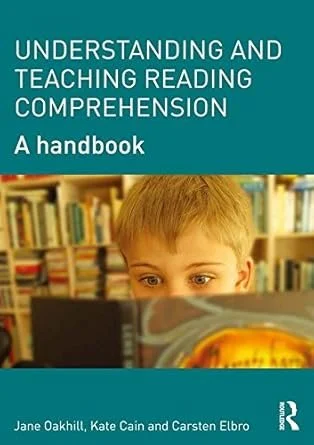Understanding and Teaching Reading Comprehension
Understanding and Teaching Reading Comprehension: A Handbook
By Jane Oakhill, Kate Cain and Carsten Elbro
A great textbook for understanding the processes involved in reading comprehension
What it’s about
Understanding and Teaching Reading Comprehension takes the reader through the basic processes involved in reading, including the well-known Simple View of Reading model, and the more detailed picture presented in Scarborough’s Reading Rope. It outlines how to spot and assess poor comprehenders, and then gives a detailed discussion of the processes involved in understanding a text.
Chapters introduce each element of comprehension, and then discuss how to teach it. The main topics covered are:
inference
vocabulary
understanding sentences
text structure
comprehension monitoring.
The good
The structure of the book works well, and there is good range and depth to the content – it covers all the essentials of understanding reading comprehension, and highlights the problems that can lead to poor comprehension.
I found the chapters on inference and comprehension monitoring particularly useful when considering what areas I could work on with my adolescent pupils.
The less good
The language and style are quite academic, which probably reflects the background of the authors, who are academics rather than teachers.
In the same vein, I felt that the ‘understanding’ part of the book’s title received more attention than the ‘teaching’ part. Although examples of how to teach different aspects of comprehension are given, they are presented in quite an academic way (‘Studies have shown that…’) rather than a practical, teacher-friendly way.
From my perspective as a secondary literacy specialist, I was disappointed that there were no specific sections on teaching older learners. The teaching focus was on how to identify comprehension difficulties and adapt your teaching strategies accordingly, but there was little differentiation according to the age of the learner. I would have found it useful to have more guidance on when specific comprehension skills are expected to develop, and to what extent poor comprehension (independent of poor decoding) exists in adolescents.
The takeaway
I’d recommend this book to people looking to learn about reading comprehension processes. It also provides a starting point for how to teach the different components of reading comprehension, but it’s not a practical, in-depth handbook for improving students’ comprehension.
(As a note of caution for those looking to learn about teaching literacy to adolescents and with limited time or money: In my experience, most comprehension issues in adolescents are caused by deficits in decoding, vocabulary or fluency, so these are the areas in which literacy teachers should focus their professional development.)
Podcast pairing
For an overview of the topics in this book, listen to Jane Oakhill on Season 3 Episode 1 of Science of Reading: The Podcast

